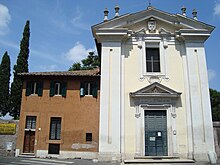Church of Domine Quo Vadis
| Church of St Mary in Palmis Chiesa di Santa Maria delle Piante (Italian) Sanctae Mariae in Palmis (Latin) |
|
|---|---|
 |
|
| Basic information | |
| Location |
Via Appia Antica, 51 Rome, Italy |
| Geographic coordinates | 41°51′59.4″N 12°30′13.4″E / 41.866500°N 12.503722°ECoordinates: 41°51′59.4″N 12°30′13.4″E / 41.866500°N 12.503722°E |
| Affiliation | Roman Catholic |
| Ecclesiastical or organizational status | Parish church |
| Leadership | Fr. Marian Babula, C.S.M.A. |
| Website | vicariatusurbis.org |
| Architectural description | |
| Architectural type | Church |
| Completed | 1637 |
| Specifications | |
| Direction of façade | Southwest |
| Length | 17 meters (56 ft) |
| Width | 11 meters (36 ft) |
The Church of St Mary in Palmis (Italian: Chiesa di Santa Maria delle Piante, Latin: Sanctae Mariae in Palmis), better known as Chiesa del Domine Quo Vadis, is a small church southeast of Rome, central Italy. It is located about some 800 m from Porta San Sebastiano, where the Via Ardeatina branches off the Appian Way, on the site where, according to the apocryphal Acts of Peter, Saint Peter met Jesus while the former was fleeing persecution in Rome. According to the legend, Peter asked Jesus, "Lord, where are you going?" (Latin: Domine, quo vadis?). Jesus answered, "I am going to Rome to be crucified again" (Latin: Eo Romam iterum crucifigi).
There has been a sanctuary on the spot since the ninth century, but the current church is from 1637. The current façade was added in the 17th century.
It has been supposed that the sanctuary might have been even more ancient, perhaps a Christian adaptation of some already existing temple: the church is in fact located just in front of the sacred campus dedicated to Rediculus, the Roman "God of the Return". This campus hosted a sanctuary for the cult of the deity that received devotion by travellers before their departure, especially by those who were going to face long and dangerous journeys to far places like Egypt, Greece or the East. Those travellers who returned also stopped to thank the god for the happy outcome of their journey.
The presence of the Apostle Peter in this area, where he is supposed to have lived, appears to be confirmed in an epigraph in the Catacombs of Saint Sebastian that reads Domus Petri (English: House of Peter). An epigram by Pope Damasus I (366–384) in honor of Peter and Paul reads: "You that are looking for the names of Peter and Paul, you must know that the saints have lived here."
...
Wikipedia
